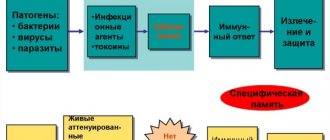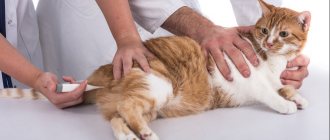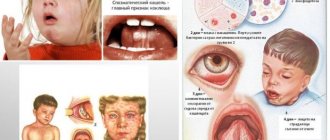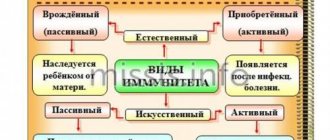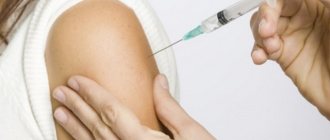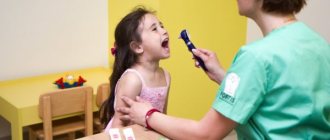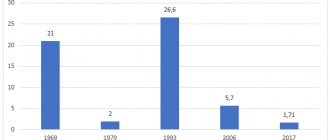Vaccine options
Pertussis vaccine is usually produced in combination with diphtheria and tetanus toxoids (DPT).
The domestically produced vaccine contains a more reactogenic, but also more immunogenic whole-cell pertussis component. In addition, domestically produced combination drugs “Bubo-M”, “Bubo-Kok” and “DTP-HepB” are produced, as well as imported vaccines “Pentaxim”, “Infanrix Penta”, “Infanrix Hexa”, “Tetraxim”, “Infanrix” " Imported AaDPT vaccines (Adsorbed acellular Pertussis-Diphtheria-Tetanus vaccines) contain an acellular pertussis component, which is better tolerated than whole cell, but has lower immunogenicity. Imported vaccines, as well as, for example, the BUBO-Kok vaccine, are often combined with vaccines against hepatitis B, polio (inactivated) and Haemophilus influenzae type b. For age-related revaccinations against pertussis in children over 6 years of age and adults, as a rule, combination vaccines with an acellular pertussis component are used, which also include a reduced content of diphtheria toxoid and tetanus toxoid (Adasel vaccine).
Whooping cough vaccine
I rang the doorbell of the apartment. It was dark in the corridor. The air is filled with the smells of some Indian incense. In the corner is a scratched snowboard with the word Liberty written on it. My dad met me in a colorful skirt, with pale features, and led me into the room. In the room, instead of a bed, I saw a mattress lying on the floor, covered with blankets. My mother was reclining there, with a dot drawn on her forehead. A one-year-old girl was sitting in her mother’s arms.
Having sat down somehow, I began to collect an anamnesis.
“Tell me the child’s last name, first name and date of birth,” I asked. -Her name is Kishori. - Ki-sho-ri? Right? - I asked again. - Surname? - Kondratenko.
Everything was almost clear.
Pediatricians are afraid of children with rare names, or rather, not children, but those who named them that way. A call to the boy Ogneslav will most likely lead to intimate conversations about bioenergy and herbs. Parents who named their daughter Diodora will most likely not follow the recommendations of a doctor of traditional medical orientation. A child named Bartholomew is highly likely to have no vaccinations. They will call Luke only when all prayers have been exhausted.
One-year-old Kishori has been coughing for three weeks now.
- Probably teeth? - the parents asked the traditional question. - Let's listen. Undress.
Kishori immediately became very upset, screamed and waved her arms. Suddenly she broke into a coughing fit. She coughed for about ten seconds, and then suddenly noisily inhaled air and stopped breathing. Her face turned blue. The mother clumsily shook the child. I took a book from the shelf with the inscription "Mahabharata" and told dad to wave it in front of the child's face, creating a stream of air. I myself grabbed the girl by the heel and pinched her hard. The girl finally started breathing. The diagnosis was clear. Severe whooping cough in an unvaccinated child, possibly complicated by pneumonia. The appearance of the parents and the name of their daughter left no doubt about the absence of vaccinations.
“We never thought that the child would catch whooping cough.” We are not against vaccination, we just thought about getting the vaccine sometime later, when she grows up...” Dad justified himself dejectedly.
- Listen, do you notice where you live? - I exclaimed. — On a desert island with palm trees and sun? You live in a huge city with a lot of people. Many of them suffer from various diseases. When you leave your cozy apartment and go down the stairs, you probably change your wonderful skirt? Are you wearing jeans and a down jacket? After all, wearing a skirt and sandals in winter in Russia doesn’t look particularly good. So a child needs vaccination precisely because he lives here, among people who can infect him. The vaccine is his protection, warm clothes with a membrane!
It took three weeks of hospitalization, a couple of antibiotics and anticonvulsants to bring Kishori out of this terrible disease. But the baby might not have gotten sick!
History of whooping cough vaccine
The whooping cough vaccine appeared in the USSR in the late 1950s, after which the incidence of the disease sharply decreased. Mortality from whooping cough has dropped a thousand times. And as always happens, as soon as a disease becomes rarer, people begin to forget about its danger. And the safety of vaccination comes to the fore.
The first generation of whooping cough vaccines, which are still used in a number of countries around the world, including Russia, actually contain whole whooping cough cells. This leads to the development of good immunity.
On the other hand, reactions occur quite often in response to the administration of such a vaccine. This includes temperature, pain, and swelling at the site of infection. Very rare, but sometimes complications still occur - convulsions, encephalopathy.
The second generation of whooping cough vaccines contains only selected antigens of the microbe - this is the so-called acellular (acellular) vaccine. An important advantage of acellular vaccines is their greater safety and better tolerability.
According to studies, the incidence of fever above 40 degrees after administration of the acellular vaccine is 1 in 16,000 doses versus 1 in 330 after the whole-cell vaccine. The risk of seizures after an acellular vaccine is 1 in 14,000 (for a whole-cell vaccine it is 1 in 1,750). Anaphylactic reactions occur with a probability of one in a million versus one in 50,000, respectively.
Features of the vaccine
The disadvantage of the whooping cough vaccine is its relatively short immunity. On average it is 5–6 years. Therefore, for example, in the USA, revaccination is carried out additionally before school, and also at 12–13 years of age. In addition, they recommend that all pregnant women at 27 weeks be vaccinated against whooping cough. This is due to the fact that a newborn baby can become infected with whooping cough immediately after birth, and vaccination is allowed only from 2 months of life. If the mother is vaccinated during pregnancy, she will transmit passive immunity against this infection to the newborn.
Remember that whooping cough in the first half of life is especially malignant and even causes death.
In Russia, the last vaccination against whooping cough is given at 1.5 years. At 6 years of age, revaccination is given with the ADS-m vaccine (without the pertussis component). This is why whooping cough regularly occurs in our schoolchildren, albeit in a mild form. But even if you want to revaccinate your child before school on your own, you won’t be able to do this. The fact is that the whooping cough vaccine for children over 7 years of age and adults also differs from the usual acellular vaccine in its reduced content of components. Such a vaccine is not produced in Russia, and Western analogues have not been registered. This is something the Russian Ministry of Health should work on...
Thus, if there are no contraindications, you should not postpone vaccination against whooping cough (allowed from 3 months). Of course, it is safer to get a modern acellular vaccination. But if this is not possible, vaccinate your child anyway. After all, whooping cough in an unvaccinated person is much more severe than any reaction to a vaccine, not to mention the fact that complications after vaccination are extremely rare.
Another option is to hide on a desert island. However, they have their own diseases.
Mikhail Nikolsky
Photo istockphoto.com
Principles and purposes of vaccination
The main purpose of vaccination against whooping cough is to reduce the risk of acute whooping cough in infancy. It is important to note that children in the age group from 7 to 14 years occupy a leading place in the structure of cases due to the weakening of post-vaccination immunity just by the age of 6–7 years. In school-age children and adults, whooping cough can also be very severe, therefore, to prolong immunity, it is possible to carry out age-related revaccinations at older ages. Moreover, it is school-age children, as well as parents, who are one of the main sources of infection for unvaccinated children in the first months of life, in whom whooping cough is especially severe.
Vaccine effectiveness
Despite significant differences in content and method of manufacture between whole-cell and acellular pertussis vaccines, comprehensive clinical trials have shown that the most effective vaccines of either category protect more than 85% of vaccinated individuals from clinical manifestations of the disease. The best acellular vaccines are as effective as the best whole cell vaccines (85%).
There is still debate about whether monovalent or bivalent acellular vaccines (containing inactivated pertussis toxin alone or in combination with FHA) are as effective as multivalent acellular vaccines (containing 3-5 components). However, all licensed acellular vaccines have been shown to be highly effective in controlling pertussis in infants and young children, provided adequate vaccine coverage (>90%) is achieved.
In 2008, approximately 82% of all infants worldwide were vaccinated with three doses of pertussis vaccine. WHO estimates that approximately 687,000 deaths were prevented by pertussis vaccination in 2008.
Post-vaccination reactions
If vaccinations are carried out with DTP vaccines, then it should be remembered that these vaccines are the most reactogenic, “heavy” vaccine preparations. On average, adverse events occur in a third of vaccinated people. They are manifested by a moderate increase in body temperature and mild malaise within 24 hours after vaccination. As a rule, all post-vaccination reactions to DTP vaccines develop no later than 72 hours after vaccination and last no more than 48 hours. Acellular vaccines are considered less reactogenic. The most characteristic features of acellular vaccines are the low incidence of temperature reactions, local reactions at the injection site and, most importantly, the incidence of post-vaccination complications.
What complications can there be?
In most cases, vaccination does not cause complications except for swelling at the injection site and tissue hardening. General reactions are very rare, but even they do not pose such a danger to the body as the consequences of whooping cough in an unvaccinated state. The maximum that can be expected is prolonged crying of the baby along with a rise in body temperature, urticaria, and a general deterioration in health, but the percentage of such complications when using high-quality vaccines is extremely low.
Risk of post-vaccination complications
Possible specific complications of DTP vaccines include neurological complications, which are extremely rare. It is believed that they may be caused by the fact that the toxins (even inactivated) of pertussis bacillus in combination vaccines tend to irritate the meninges of a very small proportion of susceptible children. Complications in the form of encephalopathy are less than 1 case per 300 thousand vaccinated people.
Currently, in the world, convulsions without fever are not considered a complication of vaccination. Research conducted in Great Britain in 1960-1970. indicate the same frequency of seizures in both vaccinated and unvaccinated children. Moreover, the first manifestations of diseases such as epilepsy and organic brain damage can appear at the age of 3-4 months in the form of seizures, when vaccination is carried out, and are associated with vaccination only by a temporary factor.
The development of afebrile seizures indicates the presence of an organic lesion of the nervous system in the child, which was not taken into account and identified or could not be identified before vaccination for objective reasons. Therefore, in the event of afebrile seizures, a comprehensive neurological examination is necessary to make a diagnosis.
Contraindications to pertussis vaccination
It should be noted that after vaccination, the risk of contracting whooping cough remains, since after a few years its effect weakens. In addition, infection can occur if the child was given a low-quality vaccine. However, in practice this happens extremely rarely.
Vaccine administration may be delayed under the following conditions:
- The child suffers from an acute illness, or his chronic illness has worsened. Until the baby's condition is stabilized, he will not be vaccinated.
- If the previous vaccination caused severe allergic reactions, then further administration of the vaccine should be abandoned.
- Diseases of the nervous system that tend to progress are an obstacle to injection.
- If a child has already had whooping cough, he is not vaccinated for some time.
A slight runny nose and mild sore throat are not contraindications to the vaccine. However, if the doctor deems it necessary, he will delay the scheduled vaccination.
When to vaccinate?
From 3 months. Vaccination is carried out three times with an interval of 45 days and a single revaccination 12 months after the 3rd vaccination, i.e. at 18 months of age.
The optimal strategy for controlling pertussis infection is the maximum timely coverage of preventive vaccinations for children in the first two years of life within the time frame recommended by the national calendar of preventive vaccinations (at 3-4.5-6-18 months); catch-up immunization of children not vaccinated in a timely manner; carrying out age-related revaccinations against whooping cough in children aged 6-7 years, 14 years old, adolescents and adults from 18 years old every 10 years from the date of the last revaccination.
Answers to frequently asked questions
- Is the whooping cough vaccine given to adults?
No, vaccinations are not carried out in adults. The disease is especially dangerous for children. Adults, apart from a lingering cough, do not experience any other complications of the disease. Pregnant women are also not vaccinated against whooping cough.
- How long does immunity to whooping cough last?
The vaccine is valid for 3-5 years. Although the cells can circulate in a child’s body for up to 12 years in a row.
- Can you get whooping cough after receiving the vaccine?
Yes, this risk remains. This happens because the vaccine was of poor quality, or many years have passed since the vaccination. Therefore, teenagers and adults can get whooping cough, but their illness is mild.
For reference: before the development of the vaccine, whooping cough claimed a huge number of children's lives. Therefore, after its introduction to the masses, people considered the whooping cough vaccine to be almost a magical remedy that would save the life of a child. It should be noted that little has changed since then, and the vaccine is the only way to protect a child from a fatal disease.
Author of the article:
Danilova Tatyana Vyacheslavovna |
Infectious disease specialist Education: in 2008, received a diploma in the specialty “General Medicine (Therapeutic and Preventive Care)” at the Russian Research Medical University named after N. I. Pirogov. I immediately completed an internship and received a diploma as a therapist. Our authors

